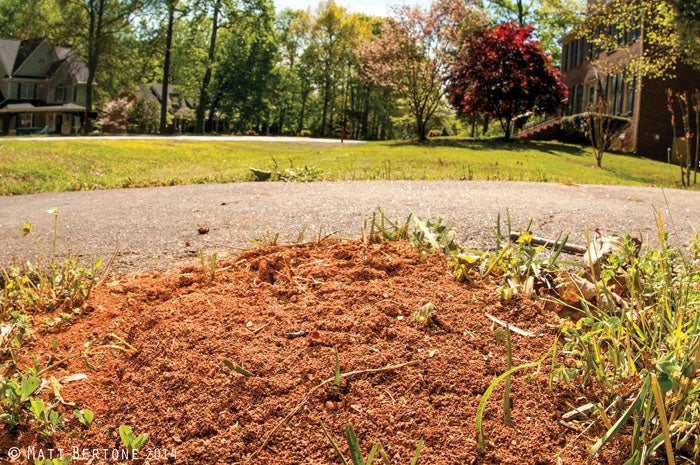Amy-Lynn Albertson: Fire ants in the landscape and lawn
Published 12:00 am Sunday, August 29, 2021

- Fire ant mound in the lawn: photo courtesy of Matt Bertone NCSU
By Amy-Lynn Albertson
N.C. Extension
The red imported fire ant is an introduced species from South America that has established itself through most of North Carolina and Rowan County. Fire ants like to nest in open sunny areas, especially in disturbed soil. Open spaces are why lawns and pastures are often problem areas with fire ants. There are several practices and design elements you can use to make it less attractive to fire ants in the landscape. Planting shade trees will make your landscape less desirable for fire ants and increase habitat diversity. It’s important to realize that not all ants are bad, and a diverse habitat encourages competitor ants. Several ant species will attack and kill newly mated fire ant queens.
They also raid and kill off small fire ant colonies. You can encourage native ant predators by creating ideal nesting sites. Small rock or board piles in shaded areas or tall grass areas along landscape edges and the base of tree trunks are great sites for native ants. Purple martins are birds that are insect predators. Although the impact of this predator on fire ants is not documented, it should have a positive effect on swarming reproductive males and females. Placing purple martin birdhouses in the landscape to provide nesting will encourage the birds to stay. You can also discourage fire ants in the landscape by keeping garbage cans and pet food bowls clean. Fly larvae in pet poop serve as food for fire ants. You can avoid this problem by removing and throwing away the excrement. Fire ants need water daily. To limit fire ant nesting, conserve water, fix leaky faucets, irrigation valves, and heads, improve drainage, and practice water-wise landscaping techniques. None of these practices will eliminate fire ant colonies. Still, they may help reduce ants, insecticides, and baits needed to manage fire ants in the landscape.
On the lawn, we recommend you use the two-step method of managing fire ants. The first step is to put bait out over the entire lawn area. Then after a week, treat the individual mounds where people or pets will come into contact with the ants. Late August through early October is an ideal time to apply fire ant bait to your lawn. Some brand names of baits available for use on home lawns are Amdro, Siege, Logic, Award, Ascend, or Raid Fire Ant Killer. These baits are a mixture of insecticide and food that is attractive to fire ants. The worker ants will carry the bait back to the mound and feed it to the brood (larvae or immature ants) and the queen. Even if the insecticide kills the queen, the workers may still be active inside the mound for several weeks before the colony disappears. Baits are slow-acting, taking weeks to months to reduce ant mound numbers. However, baits usually achieve 80-90% control. I have made putting out fire ant bait part of my annual lawn maintenance and treat in the spring and the fall. It’s essential that the bait be fresh, so don’t buy more than you need and make sure it’s not expired. Seven to 10 days after applying the bait, an insecticide can be used directly on the mounds that are in high traffic areas or where people and pets may come into contact with them. Liquid drenches generally eliminate mounds within a few hours and leave little surface residue after application. Granular products are relatively fast-acting, requiring you to granules on and around the mound and sprinkle 1-2 gallons of water on it without disturbing the mound. As always, follow the label closely. For more information on fire ant management or other horticultural topics, contact the Rowan County Extension Center at 704-216-8970
Disclaimer: The use of brand names and any mention or listing of commercial products or services in this publication does not imply North Carolina State University’s endorsement or discrimination against similar products or services not mentioned.
Amy-Lynn Albertson is director of the Rowan County Extension.




